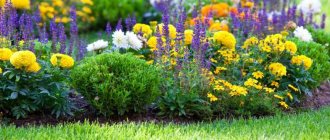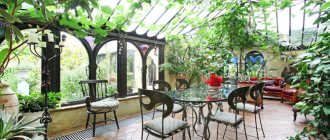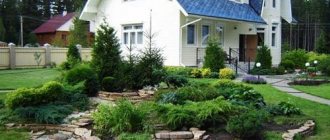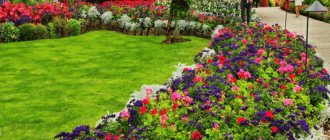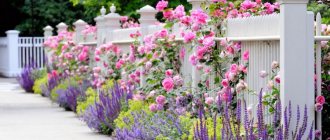What is a discount?
Before you start designing a flower bed, you should familiarize yourself with the simplest design of a flower bed. As a rule, this type of flower garden is a planting of flowers in the form of a square or rectangle.
Place the ridge along garden paths or near the walls of a residential building. There is a pattern in the arrangement of flowers: taller crops are planted in the center, and as they move towards the periphery, plant growth decreases. There are also a number of rules regarding the design of this model of flower beds:
- The maximum width of the ridge reaches 300 cm. There are no such strict rules regarding the length of flower plantings.
- Planting flowering crops near residential buildings, gazebos, and paths is intended to focus attention on a building or other structure.
- A maximum of 3 varieties of plants are used in the design of a flower garden. A flower bed that is too colorful will irritate the observer's eye.
Work on arranging such a stylish flower bed should be carried out only according to a pre-designed flower bed scheme, which takes into account the type of soil and soil acidity, preferences for sunlight and watering characteristics for plants.
These types of flower beds should not be confused with mixed flower beds, in which there is a certain randomness of green spaces. Photos of various models of flower beds will help you appreciate all the advantages of this type of flower bed.
Mahonia
Mahonia is an evergreen shrub that is quite suitable for gardens in the middle zone. The plant is very decorative; its carved bright green foliage becomes brownish-purple with a violet tint in the cold season. Dark blue berries hang in voluminous clusters. By the way, they are edible and have a soft and delicate taste. The fruits are stored for quite a long time.
The root system of Mahonia penetrates into the soil at a sufficient distance to obtain moisture even in extreme conditions. Fertile, slightly acidic soil, always without stagnant groundwater, is most suitable for shrubs. If there is no rain for a long time during the season, the bush must be watered. A bucket of water is poured onto one plant once every two weeks.
Mahonia is planted along paths; Small bushes can be used to delimit the garden area into zones. It will not grow too tall and will successfully serve as a small fence.
Main types of discounts
There are several main varieties of rabatka flower beds:
- One-sided flower bed. It has the characteristic appearance of a long narrow strip of flower plantings. As a rule, such models are installed along walls, garden paths, and fences.
- A double-sided flower bed is a more advanced version of a flower bed. Used to limit and visually highlight a driveway, alley, or descent to an artificial reservoir.
- Intermittent flower bed. Dense rows of flowering plants can be interrupted by a boxwood bush, lush kochia or stone structures. An excellent option for those owners who prefer minimalism and brevity in their landscape.
- The ridge can be made only from perennials or be of a mixed nature.
Double-sided flower beds, in turn, are divided into symmetrical and asymmetrical models. There can be any number of tiers inside the ridge, depending on the skill and abilities of the gardener (landscape designer).
The number of shades used may also vary (from two-tone to complex multi-color plantings).
Tall flowers
A winding path bordered by rich greenery Source www.botanichka.ru
For floral edging of the border of a garden path, plants with a height not exceeding 40-50 cm are used. As an example, consider options for using annual representatives of this group:
- Ageratum Houston (Mexican) is a heat-loving variety, planted after the threat of night frosts has passed. The plant blooms in lush baskets of small flowers in pink, blue, and purple shades. Creates a lush surface, the height of which is adjusted by pruning the shoots. Recovers in a few days. It blooms in early June and remains in this fragrant state until the first frost.
- Salvia (sage) - the flower reaches a height of up to 50 cm. For border frames, low-growing varieties are used: “Fireball”, “Vesuvius”. It is grown only through seedlings. The bright red flowers of the plant harmonize perfectly with the miniature yellow leaves of marigolds or silvery ciniririums.
Beautiful perennials Source flo.discus-club.ru
- Hybrid nasturtium - the plant will decorate the landscape design of the garden not only with voluminous, rich flowers of light yellow or fiery red, but also with original leaves. Large, rounded, suspended cuttings look impressive. To decorate the border of a flower bed, bush varieties are used: “Strawberries with Cream” and “Jewel Mix”; species with unusual variegated leaves are also used: “Alaska Golden”, “Alaska Scarlett”.
- Coreopsis - yellow, orange or golden flowers on a thin stalk can be planted in open ground. For this purpose, the Crimson King variety is used, reaching a height of 30 cm.
Step-by-step creation of a discount
Work on creating a discount with your own hands should begin with preparing a diagram. Rabatka is a rather complex element in landscape art.
Ensuring active flowering throughout the season is possible only with proper organization of the flower garden. The best option would be to prepare a project in which the gardener must display a number of parameters:
- Dimensions of the ridge, its width and length.
- Varieties and colors of plants used.
- Location of tiers and their number.
- Color pattern inside the flower bed.
It is important to familiarize yourself in advance with the care requirements of the crops used (organization of watering, growth and flowering activity in different periods, the need for fertilizer, requirements for sunlight).
How to highlight oddly shaped paths
“Fantasy” paths, lined with slabs of fancy shapes and with uneven outlines, are also best designed using creeping types. Sometimes, to enhance the decorative effect, some plants are mounted directly into the cracks among the slabs using a knife.
Fantasy track
Another important point in the design of bizarrely shaped paths: in places of branching or at turns, it is appropriate and even desirable to plant some large architectural plants, such as buzulniks.
Large plants that are visible from afar are usually planted at the bend of the path. Photo by the author
Planting plants in a flower bed
The next step for the gardener or landscape designer is to optimally plant flowering crops. To do this, most often follow the instructions on how to make a discount:
- The selected area is marked with pegs and rope.
- Next, you need to remove the top layer of soil, which is 10-15 cm.
- Border material is laid along the edges of the future flower bed. This could be stone, broken gravel, masonry, decorative borders made from glass bottles. Fencing is an important element of any flowerbed, which prevents excessive plant growth and favorably emphasizes the style of the flowerbed.
- Mix nutritious soil, the composition of which depends on the varieties of plants chosen for the flower garden. It is better to purchase the soil from a specialized store or treat it yourself against pests and fungi. With this approach, plants will be maximally protected from the action of pests, fungi and various microorganisms.
- The soil is laid on the prepared site and leveled.
Flowers are planted according to the prepared scheme. It should be remembered that the central rows are occupied by the tallest plants, and the periphery is intended for planting low-growing crops. In practice, you can find ridges that have only one tier.
Rules for planting trees and shrubs along fences and paths
When landscaping, the main thing is to correctly form all the plants and link them into a single whole. In this case, all vegetation will be in the human field of vision. All the colorful variety will be available for viewing and aesthetic pleasure.
Scheme for planting shrubs along the fence
In the spring, you will receive a real fairy tale of flowers, petals and young greenery, which can be combined into a single fresh composition across the site. And the sight of the autumn colorful palette, consisting of all known shades of green, brown, yellow, red and orange, will blow your mind. To do this, it is important that the following conditions are met:
1. The farther the plants are located from the path, the taller they should be.
2. Nearby trees and shrubs should not have tall forms that block the entire view.
3. Vegetation should not be the same in color and height, unless this should be a creative decision of the designer.
4. The diverse flora looks more interesting, creating a riot of colors and heights on the spot.
Formed hedge planting table
Features of flower garden care
When arranging a flowerbed, not only a carefully prepared planting plan is important, but also practical care of the flowerbed. For long and beautiful flowering, it is important to carry out timely watering, removing weeds and faded plants, loosening the soil and weeding.
Be sure to organize a good drainage layer at the stage of arranging the selected site. It is important to focus on the care features of specific varieties.
Barberry Thunberg
Admiration is one of the shortest varieties of Thunberg barberry. It grows slowly and reaches half a meter in height. Bushes are often planted along paths and delimit the garden area. Admiration's leaves are edged, beautifully shaped, shiny and smooth. The crown is uneven, rounded.
The culture is resistant to drought and strong winds. Can grow normally in smoky areas. It tolerates slight soil acidification without problems. Admiration grows best near a body of water. Suitable for urban environments. Barberry is a good honey plant; it will attract pollinators for fruit trees to the site. The leaves of this variety are edible and used in cooking.
How to create paths in a lazy garden
For “lazy” (that is, extremely busy) gardeners, it is better to use shrubs in the design of paths, which, although they do not look as impressive as flower arrangements, are unpretentious, keep their shape and are decorative all season long. In first place among them are the cinquefoil bush and dwarf varieties of Japanese spirea.
Left: Potentilla blooms all summer long. Right: Spiraea japonica 'Golden Princess' in spring. Photo by the author
However, in the end, when choosing a design option, you should be guided not only by your desires to decorate the garden, but first of all by your own abilities to maintain decorative compositions in order. And also, try not to overload the space with unnecessarily complex options.
An overly variegated flower garden. Photo by the author
How do you design paths in your garden, what plants do you use for this? Share your experience in the comments.
Source
